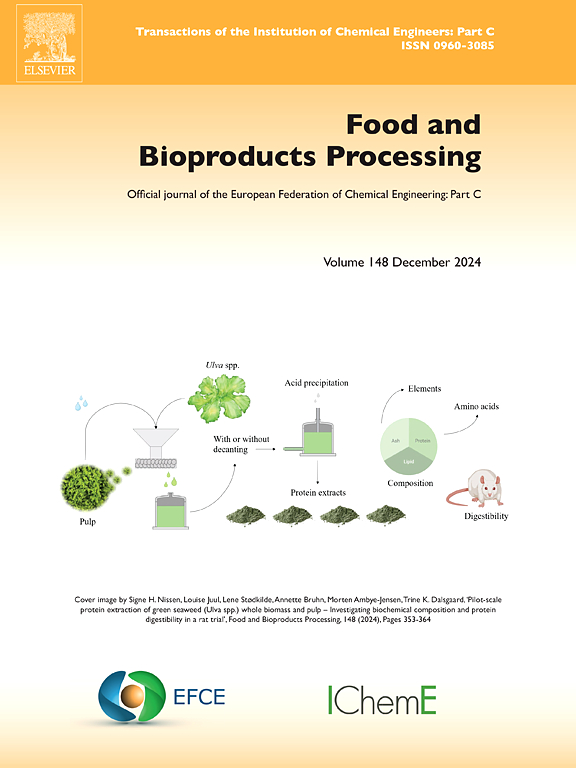Multi-scale convolution and dynamic task interaction detection head for efficient lightweight plum detection
IF 3.4
2区 农林科学
Q2 BIOTECHNOLOGY & APPLIED MICROBIOLOGY
引用次数: 0
Abstract
Automating fruit detection is crucial for boosting efficiency and ensuring high-quality produce. Plums, scientifically known as Prunus salicina, presents a unique challenge due to their soft texture, vulnerability to damage, and frequent instances of overlapping. These traits complicate manual inspection and present significant obstacles for automated systems. In addition, plum detection devices often face limitations in computing power and storage space, demanding high performance in terms of model lightweighting. To meet the requirements for detection performance and lightweighting in practical plum detection, we propose a novel, high-precision, lightweight plum detection model based on YOLOv8n, named Efficient Lightweight Plum Detector (ELPD). Our model introduces several innovations: we propose Potently Efficient Multi-Scale Convolution (PEMSConv) to enhance the model’s capability in extracting multi-scale features, improving detection accuracy while reducing model size. Additionally, we introduce Dynamic Task Interaction Detection Head (DTIDH) to enhance the interaction between classification and localization tasks, boosting detection performance while the use of shared convolution further reduces the model size and parameters. Moreover, we propose Focaler-Minimum Point Distance Intersection over Union (Focaler-MPDIoU), which enables the model to focus on the majority of samples in the dataset based on their difficulty, further enhancing detection performance. Focaler-MPDIoU also considers various geometric properties of bounding boxes, accelerating model convergence. Finally, we evaluate our model using a dataset from a plum orchard. In terms of detection performance, our model outperforms the baseline model with improvements of 2.03% in [email protected] and 1.02% in [email protected]:0.95. Regarding lightweight efficiency, our model achieves reductions of 32.53% in model size and 35.19% in parameters compared to the baseline.
多尺度卷积和动态任务交互检测头实现高效轻量级李子检测
自动化水果检测是提高效率和确保高质量产品的关键。李子,科学上被称为Prunus salicina,由于其柔软的质地,易受伤害,并且经常重叠,因此呈现出独特的挑战。这些特点使人工检查复杂化,并为自动化系统带来了重大障碍。此外,李子检测设备往往面临计算能力和存储空间的限制,在模型轻量化方面要求高性能。为了满足实际李子检测对检测性能和轻量化的要求,我们提出了一种基于YOLOv8n的高精度、轻量化李子检测模型——高效轻量级李子检测器(Efficient lightweight plum Detector, ELPD)。我们的模型引入了几个创新:我们提出了高效多尺度卷积(PEMSConv)来增强模型提取多尺度特征的能力,在降低模型尺寸的同时提高检测精度。此外,我们引入动态任务交互检测头(DTIDH)来增强分类和定位任务之间的交互,提高检测性能,同时使用共享卷积进一步减小模型大小和参数。此外,我们还提出了Focaler-Minimum Point Distance Intersection over Union (Focaler-MPDIoU)算法,该算法使模型能够根据难度对数据集中的大多数样本进行集中,进一步提高了检测性能。Focaler-MPDIoU还考虑了边界框的各种几何性质,加速了模型的收敛。最后,我们使用来自梅园的数据集来评估我们的模型。在检测性能方面,我们的模型优于基线模型,[email protected]提高了2.03%,[email protected]提高了1.02%:0.95。在轻量化效率方面,我们的模型与基线相比,模型尺寸减少了32.53%,参数减少了35.19%。
本文章由计算机程序翻译,如有差异,请以英文原文为准。
求助全文
约1分钟内获得全文
求助全文
来源期刊

Food and Bioproducts Processing
工程技术-工程:化工
CiteScore
9.70
自引率
4.30%
发文量
115
审稿时长
24 days
期刊介绍:
Official Journal of the European Federation of Chemical Engineering:
Part C
FBP aims to be the principal international journal for publication of high quality, original papers in the branches of engineering and science dedicated to the safe processing of biological products. It is the only journal to exploit the synergy between biotechnology, bioprocessing and food engineering.
Papers showing how research results can be used in engineering design, and accounts of experimental or theoretical research work bringing new perspectives to established principles, highlighting unsolved problems or indicating directions for future research, are particularly welcome. Contributions that deal with new developments in equipment or processes and that can be given quantitative expression are encouraged. The journal is especially interested in papers that extend the boundaries of food and bioproducts processing.
The journal has a strong emphasis on the interface between engineering and food or bioproducts. Papers that are not likely to be published are those:
• Primarily concerned with food formulation
• That use experimental design techniques to obtain response surfaces but gain little insight from them
• That are empirical and ignore established mechanistic models, e.g., empirical drying curves
• That are primarily concerned about sensory evaluation and colour
• Concern the extraction, encapsulation and/or antioxidant activity of a specific biological material without providing insight that could be applied to a similar but different material,
• Containing only chemical analyses of biological materials.
 求助内容:
求助内容: 应助结果提醒方式:
应助结果提醒方式:


